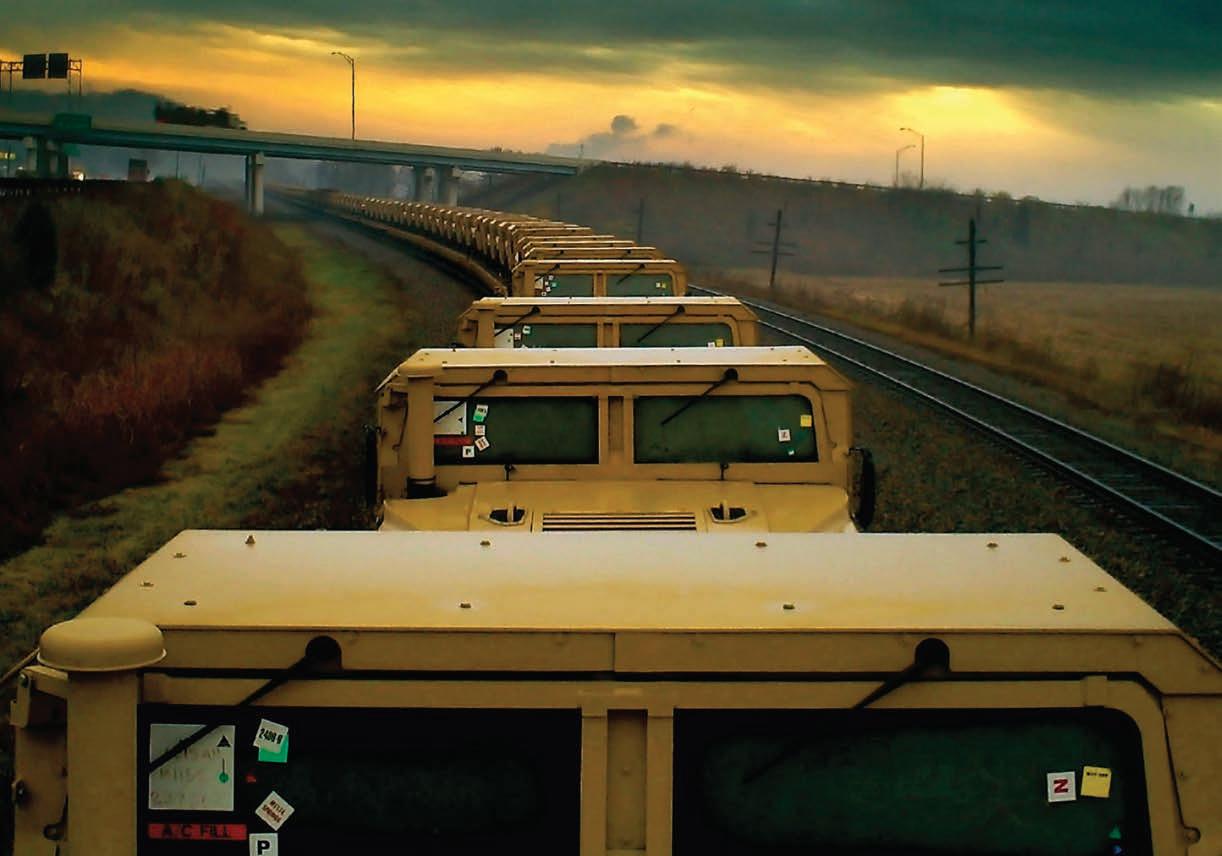
18 minute read
Perspectives on Defense Transportation: Rail
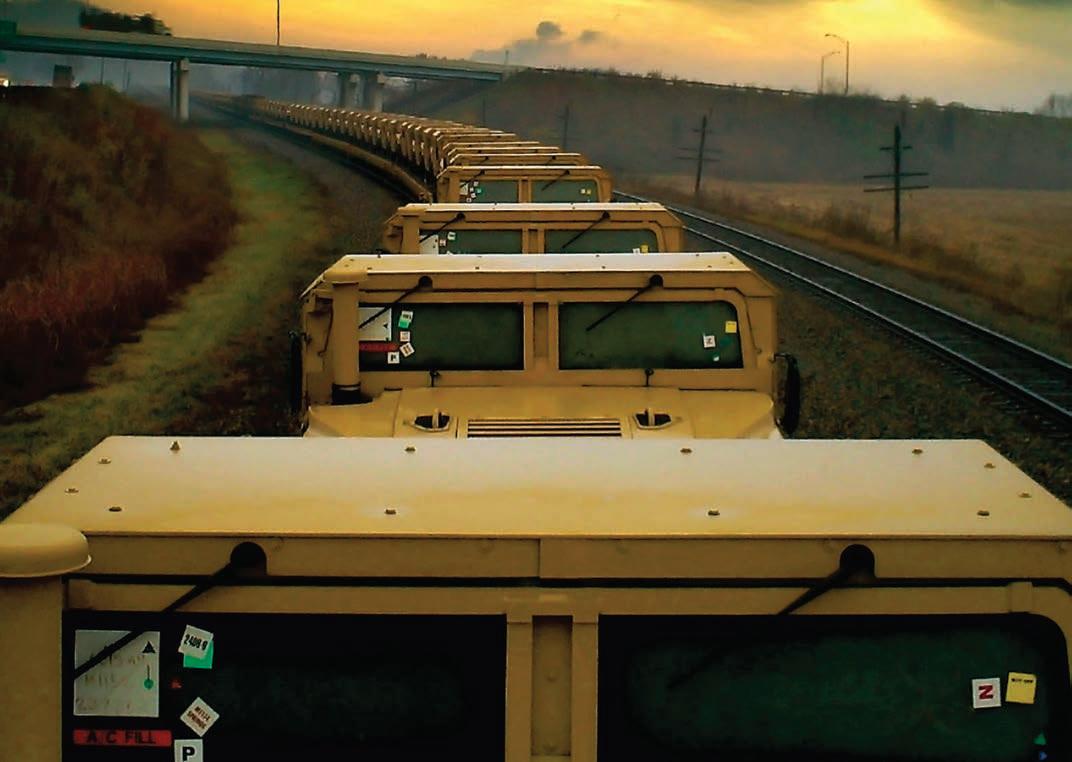
Railroads serve us well. From America’s expansion westward in the mid-1800s to moving troops, supplies, and consumer goods, our Nation has depended upon the rail industry. The June DTJ offers some perspectives starting with Warfighter needs in Afghanistan. Many thanks to all who shared rail resources: the Center for Strategic and International Studies; the Defense Freight Railway Interchange Fleet and the Rail Business Section (SDDC); Duke University Library Archives; US Transportation Museum (Ft. Eustis, VA); and our NDTA Rail Members— Association of American Railroads, BNSF, CSX, Norfolk Southern, Kansas City Southern, and Union Pacific.
Railroads to the Rescue By Denny Edwards I n WWI, it was the railroads that carried the majority of armaments, supplies, and troops that helped bring victory to the US. Sadly, the “war to end all wars” turned out to be a slogan only, and in less than 25 years we were engaged in WWII. Once again, in even greater measure, we depended on the Nation’s railroads to support the war effort. But the importance of railroads is not all about history. Fast forward to our current situation in Afghanistan, and once again it looks like rail will play a crucial role resupplying our armed forces. To transport US military supplies to the war zone from the seaport of Karachi on the Indian Ocean through Pakistan to landlocked Afghanistan, there is only one dangerous and highly vulnerable road. This 1000-mile-long route subjects civilian drivers (who are not allowed military escorts) to kidnapping, ransom, road-side bombs, and ambushes while transiting the infamous Khyber Pass and the hostile terrain of the Hindu Kush. Since early 2006, US Forces have been looking for alternate, and more secure routes to resupply Afghanistan. Their efforts bore fruit in mid-2008 with the opening of the Northern Distribution Network (NDN): several routes to the
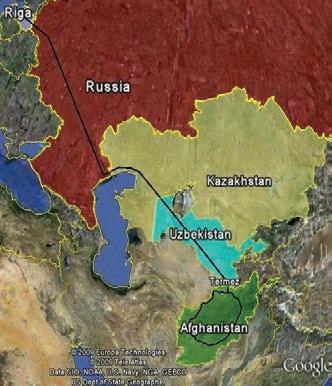
Map 1
“Make the middle of nowhere more like home.”
Go ahead, challenge us. ................................ Give Agility an impossible task and we’ll make it happen, even in the most remote locations. When it comes to delivering the comforts of home to someone half a world away, you can count on us for a supply chain that gets the job done, every time and anywhere.

North through Central Asia, in some places roughly paralleling the Old Silk Road. Not surprising, the centerpiece and most important route is the one that transfers cargo from the Latvian port of Riga to long Russian trains that carry the supplies through Kazakhstan and Uzbekistan to Afghanistan. (see map 1). It is interesting that the rail line and the equipment is the same that was built by the Russians in the 1980s to support their war with Afghanistan.
Railroads, again in a strange irony, are becoming the resource, via the NDN, that binds countries in the region together, just as they did in the early US Western expansion westward. According to US Central Command, more than 5000 containers resupplied Afghanistan from the North in 2009, and the command forecasts that fully one-third of all surface traffic will traverse the NDN in the future. If the Afghan war ends successfully, these current Military Supply Routes (MSR) could convert to a new purpose for civilian commerce and enhanced regional prosperity for nearby Central Asian nations. It could also give a new meaning to “MSR” – Modern Silk Route. Railroads are also in the news in other parts of the world. China, according to financial analyst Tom Murray, is causing a “rail renaissance” that in the last decade has produced a boom in traffic and revenue that is unprecedented in the lifetimes of today’s railroaders. More than 50 percent of the international containers moving on North American rails are carrying Chinese-manufactured goods, says the Association of American Railroads (AAR).
UP and BNSF combined have the largest market share of international container traffic entering or exiting the West Coast of the US, Canada and Mexico. Both railroads have access and provide service to the four major container ports: LA/Long Beeach, Oaklnad, Seattle and Tacoma. Network strengths, terminal options and competitive service offerings provide the UP and BNSF and advantage over other options for customers wanting to ship through the West Coast. East Coast carrier Norfolk Southern, however, is also coming on strong, mainly because of its new Heartland Corridor launched in 2007. You can learn more about the Corridor in the March 2010 NDTAGram and from Norfolk Southern President and CEO, Charles Moorman, Keynote Speaker at our Forum this September.
Also, for the first time since the demise of the US passenger train in the 1950s, rail travel is back in the news with the announcement earlier in the year of $8 billion in grants set aside to promote High Speed Intercity Passenger Rail. Although increased support for Amtrak is part of the program, it goes far beyond that. Thirteen new, large-scale, high-speed rail corridors, will be developed, and rail projects in 31 states will receive funding through the Recovery Act stimulus plan (see map 2).
United States freight railroads are also in the news. Whether because of their increasingly efficient use of fuel (on average, 480 miles on a gallon of fuel according to the AAR) or their smaller carbon foot print, rail is once again being looked at as a very crucial element in the increasing movement of freight, intermodal cargo, and the high-speed movement of people. All countries need a balanced and efficient transportation network to thrive in today’s world and rail transportation will continue to be one of the crucial components in both wartime and peace.

Map 2 Fast Facts (Brief) - RAIL
• Rail moves 43% of intercity freight—the largest of any mode. • One train load can take the load of approximately 280 trucks. • In recent years, railroads have nearly doubled their freight. volume from 1980 levels, but they did so using virtually the same amount of fuels. • Freight trains are almost four times more fuel efficient than trucks on a ton-mile basis. • The US Environmental Protection Agency (EPA) estimates that for every ton-mile, a typical truck emits roughly three times more oxides of nitrogen and particulates than a locomotive. • If just 10 percent of the freight moved by highway were diverted to rail, the nation could save as much as 1 billion gallons of fuel annually.
Military Legacy • Railways played a dominant part in the Civil War for both the North and the South. The North held the advantage because tracks had been standardized, while different gauges were in use in the South. • “In 1943, the railroads carried 730 billion ton-miles of freight—six times the total of the next largest carier, the Great Lakes ships. The total was seven times that of pipelines and more than 15 times all inter-city trucks combined. The total was 29 times that of barges and boats on inland waterways other than the Great Lakes.” • “Between December 1941 and June 1944, 23,300,000 troops were carried in organized movements within the US, and 97.75% of them traveled by rail. Army freight and express totaled 173 million tons, and all but 8.5% of that was carried by the railroads.” • Compared to WWI, there were 1/4 fewer rail employees, and 1/3 fewer locomotives, 1/4 the freight cars, and 1/3 the passenger cars—but rail moved on a monthly average about twice as many troops and nearly twice as many ton-miles of freight as in WWI. This was accomplished while rail remained in private hands.
APL is proud to announce our new PS5 service with a direct call between the U.S. West Coast and Naha, Japan.



Busan Yokohama
Naha Dutch Harbor

Part of the APL’s global U.S. Flag network, our upgraded PS5 now o ers weekly linehaul PI service between the U.S. West Coast and key military installations in the Paci c, including Naha Japan. . With the industry’s fastest transit times, and, under our constant custody, your shipments will reach their destinations swiftly, safely and securely.
Oakland
San Pedro
� 11 days Oakland toYokohama, Japan � 16 days Oakland to Naha, Japan � 14 days Oakland to Busan, Korea
For more than 160 years, APL has been proud to support the U.S. Government’s global transportation needs.
Any Mission, Any Theater, Any Time. APL will get you there. To learn more, visit www.apl.com or call 202.331.1424.
NDTA’s Rail Member companies share several things in common: they are dedicated to keeping the warfighter supplied, capable, and ready for any challenge, and they aim to create the best transportation value for the US Armed Forces. They also realize that military experience carries with it special skill sets that embody core competencies essential to corporate America, such as leadership, teamwork, and ability. For this reason, rail companies recruit veterans with confidence and provide them with continued support and opportunities during their tenure.
The Association of American Railroad s (AAR ) AAR members include major freight railroads (US, Canada, Mexico) as well as Amtrak. Membership oversees a 140,000-mile rail network and sets new standards for innovation, safety, and technology. Railroads are environmentally sensitive, energy efficient, and work tirelessly to build and expand our economy. Freight railroads meet our nation’s transportation needs today and will have an even more positive impact in the future.

Burlington Northern Santa Fe (BNSF ) BNSF serves all military installations and ports either directly or through partnerships. Main volumes of military business include service to and from the National Training Center (NTC) at Fort Irwin, California and the Joint Readiness Training Center (JRTC) at Fort Polk, Louisiana, along with deployment and re-deployment service to strategic ports and commercial ports. BNSF employs more than 6000 veterans, almost 15 percent of its workforce; approximately 100 employees are currently serving. More than 1000 BNSF employees have been called to active duty since September 11, 2001.
CSX Actual testimonials are an excellent barometer of value, and CSX employees who have served have great things to say. Here is just one example: “My transition to a civilian career was seamless and pleasant, due to similarities between military and railroad life. The biggest is how the many departments and crafts work together to accomplish a common goal. The rail industry is a dynamic operation just like the military. CSX, much like the military, has a large infrastructure where anyone with determination has the opportunity to succeed. CSX gave me all the tools I needed to start my career, and to constantly improve.”
CSX serves these strategic facilities: Fort Drum, NY (10th Mountain Div.); Ft. Bragg, NC (82nd Airborne); Ft. Stewart, GA (3rd Infantry Div.); Ft. Campbell, KY (101st Airborne Div.); Ft Eustis, VA (US Army Transport Corp); Blount Island, FL (832nd Transport Brigade); Charleston, SC (Naval Weapons Station); Savannah, GA (841st Transport Brigade); Philadelphia, PA (1192nd Transport Brigade); and Depots at Bluegrass, KY; Letterkenny, PA; Military Ocean Terminal, NC.
Kansas City Southern (KCS ) The Kansas City Southern Railway Company (KCSR) is proud to support its current employees on active duty, actively recruit new employees from the armed forces, and provide freight service to military bases. KCSR was recognized by the National Committee for Employer Support of the Guard and Reserve as a patriotic employer for contributions to national security and protecting liberty and freedom by supporting employee participation in America’s National Guard and Reserve Force. KCSR reaches out to military personnel and veterans in its recruitment efforts through job fairs and targeted advertising in an effort to hire transitioning service personnel and others with military experience. KCSR also provides freight rail service to the US Army’s Fort Polk in Louisiana and Camp Shelby in Mississippi and the military’s commercial strategic seaports at Beaumont, Corpus Christi, and Port Arthur, TX.
Norfolk Southern (NS ) Norfolk Southern (NS) is a military veteran— with service dating back to the Civil War. The partnership lives on today. During 2009, NS moved more than 6000 carloads of vehicles, fuel, and ammunition for the armed forces and national government agencies, including more than 3000 carloads of Humvees; 2500 carloads of jet fuel; 1300 carloads of trucks, jeeps, light personnel carriers, and equipment; 1000 carloads of M1, M2, and M88 tanks; ammunition; and rocket propellants. This same year, Norfolk Southern was selected by: the USAF to move missile transporters and ATK rocket boosters; NASA to move rocket motors; and the Department of Energy to move heat exchangers.
NS also moved entire divisions of Army bases as part of BRAC and will be participating in the transportation of more than 160 carloads of tanks, Humvees, and light vehicles from Fort Knox, KY, to Fort Benning, GA.
Union Pacific (UP) Union Pacific (UP) has proudly supported the US Military and the DOD for more than 100 years. Created by Abraham Lincoln with the signing of the Pacific Railway Act in 1862, Union Pacific was built with the help of many Civil War veterans who came west to survey the transcontinental route and construct the railroad. UP currently serves 22 installations, ports, and ammo depots—more military installations and ports in the Western US than any other railroad—and will be participating in the dedication of two new rail expansions at Fort Riley, KS, and the Idaho National Guard facility later this year.
The military is grateful. In 2010, Union Pacific received recognition from Vice Admiral D.J. Debbink, USN, for its strong commitment to employees serving in the National Guard and Reserve. In 2008, Union Pacific was presented the Freedom Award, the US government’s highest employer recognition.
M-ATVs Begin to Move by Rail By Jon S. Meyer, COL, USAFR (Ret.) Sr. Account Manager, CSX Transportation
On June 30, 2009, the DOD announced it had selected Oshkosh Corp. to supply MRAP All Terrain Vehicles (M-ATVs) for its fighting forces. Oshkosh has received an initial delivery order from the US Army Tank Automotive and Armaments Command (TACOM) Life Cycle Management Command (LCMC) for 2244 M-ATVs valued at $1.05 billion.
Due to the sense of urgency to deliver the M-ATVs to the warfighter, the vehicles were initially trucked to the Space and Naval Warfare Systems Command (SPAWAR) facility in Charleston, SC, for final outfitting of various classified components. Cheryl A. Thompson, Logistics Management Specialist, SPAWAR Systems Center Atlantic, was instrumental in providing the requirements for delivery to the SPAWAR facility.
Rich Howell, CSXT’s military business manager, stated, “CSXT has been pushing for more than a year to capture this business. Through a coordinated effort with the Defense Contract Management Agency’s Milwaukee, WI, office, CSXT put together pricing for a jointline move with the Wisconsin Southern Railroad (WSOR) and Canadian National Railroad from Oshkosh to Chicago. The cars are interchanged at Chicago and CSXT moves the loaded cars to Charleston.” In a competitive bid, the WSOR was selected as the winning origin carrier.
The WSOR has a loading ramp in the vicinity of the Oshkosh Defense plant, where the vehicles are loaded onto the
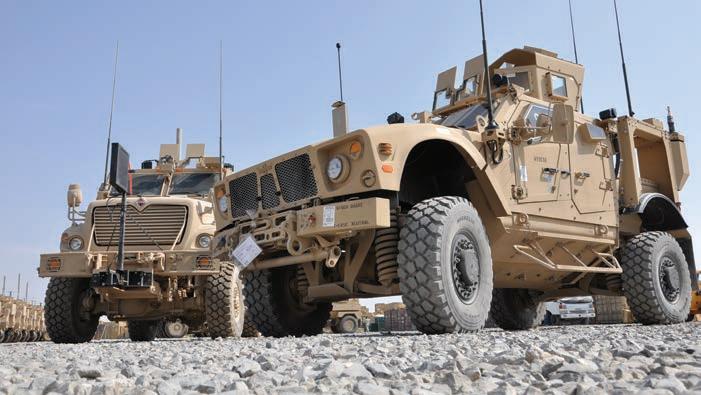
railcars. Upgrades to the ramp were accomplished to ensure the M-ATVs could be safely loaded. Jim Lombard, Vice President of Marketing, WSOR, stated, “We’re elated to be able to provide origin rail service for the movement of M-ATVs from Oshkosh Defense. While we did have to invest some capital to upgrade our loading ramp, it has been well worth the effort to support the nation’s warfighters.”
The arrangement provides for the movement of about 40 M-ATVs per week during the next several months. The MATVs are resistant to roadside bombs and better help protect military personnel in the field. They are shipped to Pakistan and Kuwait by air and ocean carrier, and are then convoyed to Afghanistan and Iraq.
TTX 89-foot flatcars are used to move the M-ATVs. The cars come equipped with tie-down chains and have a loading capacity of 140,000 lbs. Since the WSOR does not have access to this type of car, CSXT provides the cars, which are returned to Oshkosh, WI, for reloading.
Transit time is monitored from origin to destination to ensure that the cars move promptly to Charleston for unloading at CSXT’s Bennett Yard. CSXT service design personnel use the Network Operating Work Station system to provide real time visibility over the cars that move in the railroad’s freight manifest system. John Sheller, Director Flats for CSXT, is responsible for ensuring adequate car supply and transit time performance. Mr. Sheller stated, “Extensive planning has gone into securing the proper amount of railcars to support this move from Oshkosh, WI, to Charleston, SC. The transportation plan and coordinated efforts on both the loading and unloading ends has been critical in expediting these shipments for the warfighter. The plan and execution is a well oiled machine!”
Once the cars reach Charleston they are placed for unloading and delivery to SPAWAR by Star Intermodal, a subcontractor for CSXT. Star Intermodal is well experienced in loading and unloading all types of military equipment, said Ken New, President and CEO of Star Intermodal.
CSXT prides itself in providing costeffective transportation services to the Department of Defense. The company directly serves Ft. Drum, NY; Ft. Campbell, KY; Ft. Stewart, GA; and Ft. Bragg, NC. In addition, the Military Ocean Terminal at Sunny Point, NC, is served by CSXT, along with the munitions depots at Letterkenny, PA, and Bluegrass, KY. As the redeployment from Iraq continues, CSXT provides for the movement of reset fighting vehicles from various ports of disembarkation, for example, Blount Island, FL, to depots around the country.
M-ATV and the Humvee (edited from Army News Service, April 14, 2010)
The mine-resistant ambush-protected all-terrain vehicle, or M-ATV, will replace many of the up-armored Humvees in Afghanistan because it offers more protection. Third Army has been in the process of moving equipment such as M-ATVs out of Iraq as part of the drawdown, resetting that equipment, and sending what is needed to Afghanistan. While the Army isn’t finished with the Humvee, it did recently announce that it has reached its “acquisition objective” for the vehicles—meaning that it had finally received as many as it had planned to buy. The last purchase of Humvees comes to about 2662 of the vehicles, according to Vice Chief of Staff of the Army Gen. General Peter W. Chiarelli, speaking before the Senate Armed Services Committee readiness and management support subcommittee. He added that the Army plans to recapitalize 5046 unarmored Humvees, at a cost of about $55,000 per vehicle, and will recapitalize 4270 up-armored Humvees in FY 2011 at a cost of about $105-$130,000 per vehicle.
Oversized equipment and vehicles, like the M-ATV or MRAP bound for the Warfighter, are shipped via rail on flat cars that are specially outfitted to accommodate heavy loads. In many cases, the flat cars are part of the Defense Freight Railway Interchange Fleet (DFRIF; also known by their DODX reporting marks) that is owned and managed by SDDC. DFRIF cars are registered with the Association of American Railroads for use in interchange service on all commercial railroads. The DODX fleet is used in preference to commercial rail equipment to satisfy DOD Component mission requirements, except when the use of commercial equipment produces a lower overall cost. At times, commercially owned flat cars do not meet specialized military requirements or are not available in sufficient numbers. In these instances, the DFRIF “comes to the rescue” to make sure deliveries reach the ports for shipping overseas to FOBs.
The predecessor to the DFRIF originated with the purchase of tank cars during WWI in the support of ammunition production, perhaps because for the first time the government produced some of its own explosives instead of buying them from industry. During WWII, purchase of other car types as well as more tank cars caused total fleet numbers to grow. One reason for the purchase of flat cars was the increased weight of tanks and similar vehicles. Through WWII most of them could be shipped two to a commercial, four-axle flat car. The military liked the lower unit cost of shipping two to a car, and, once that was no longer possible on railroad-supplied cars, by the end of the Korean War had bought its own six-axle heavy capacity
PFC Lewis Miller & T/Sgt Robert Singer, part the valve in middle of cylinder of a2-8-2 camouflaged German engine.
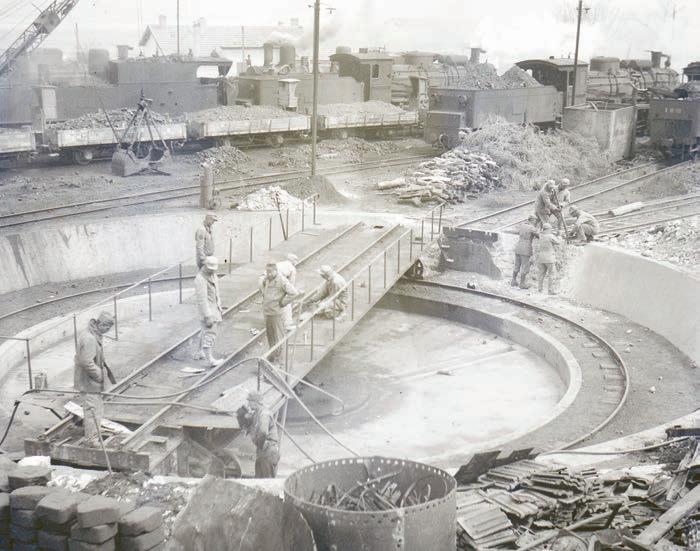
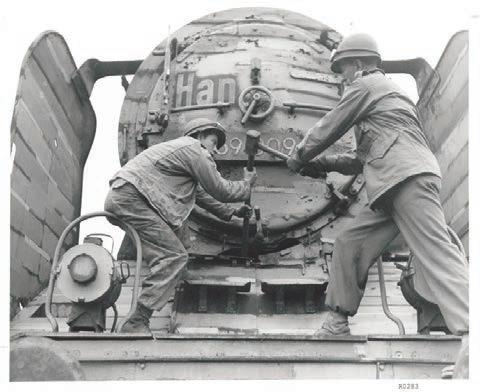
Vintage photos courtesy of the US Army Transportation Museum, Fort Eustis, VA.
flat cars in order to continue the practice. Very heavy capacity plain, depressed, and well deck flat cars were bought beginning in the1950s to handle nuclear ship parts. Until TTX Company started its QTTX fleet, the DFRIF had the largest heavy capacity flat car fleet in North America.
Although there were thousands of Petroleum, Oil, Lubricants (POL) tank cars in the fleet during WWII and the Korean War, the need for such cars was greatly reduced by the spread of pipelines and the closure of numerous air bases after the Gulf War; they now operate only in the Carolinas. On the up side, as a result of its deployment per
ETO, Dijon/Reding, Off loading, 155 MM ammunition to captured German freight cars.

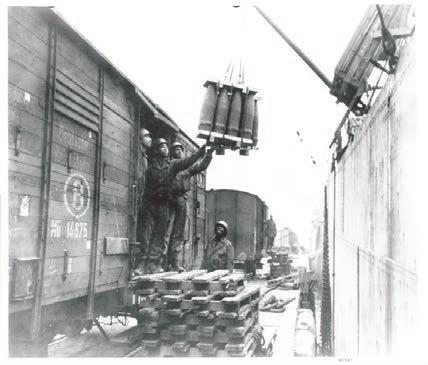

US war flat car manufactured in US for overseas use.
formance in preparation for the Gulf War, the Army decided that it needed to make major investments so that it could deploy faster. The DRIF was not neglected, with about 1100 cars being purchased, the last of them being delivered in 2001. DTJ
thank you
• Association of American Railroads (AAR) • Center for Strategic & International Studies • Defense Freight Railway Interchange Fleet, SDDC • Duke University Library Archives • Rail Business Section, SDDC • US Transportation Museum, Ft. Eustis, VA • NDTA Rail Members (AAR, BNSF, CSX, Norfolk Southern, Kansas City Southern, & Union Pacific) Many thanks in helping to prepare a DTJ salute to the Rail Industry:




